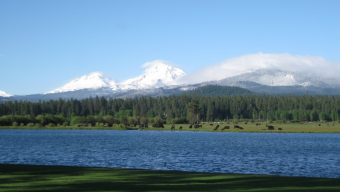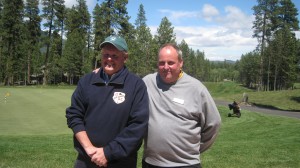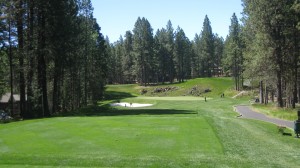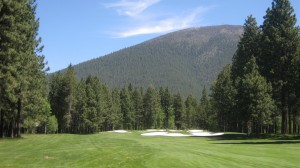BLACK BUTTE, Ore. – The spectacular scenery surrounding Black Butte Ranch’s Glaze Meadow golf course wasn’t enough anymore to entice the golfers. No matter how picturesque the package or how steep the discounts were, golfers weren’t buy it. They were sending a subtle but distinct message – by not showing up.
“We used to run about 20,000 rounds a year. But we were down to about 13,000 per year,” said Jeff Fought, director of golf for the Ranch’s Glaze Meadow and the adjacent Big Meadow course. “The infrastructure had to be fixed.”
The two venerable courses are part of the massive footprint for Black Butte Ranch, located about 30 miles northwest of Bend in Central Oregon. It’s a 1,800-acre resort community with hundreds of country-chic cabins, some as large as six bedrooms, weaving in and around the two courses with the breath-taking Three Sisters, Three-Fingered Jack, Black Butte and Broken Toe mountains, among others, looming in every direction.
However, Glaze Meadow, designed by Bunny Mason and opened in 1982, was exhausted. It didn’t need a Band-Aid, but a transplant.
“This project was originally part of our 2004-05 master plan for both courses,” said Scott Huntsman, president and chief executive officer of Black Butte Ranch. “Our plan called for minor modifications to Glaze, nothing like what was done. We saw that we needed to replace the irrigation system. It was on its last legs.”
In 2010, the community voted to authorize $3.75 million for a restoration project.
“They were nothing short of enthusiastic,” Huntsman said. “We had 83 percent voting yes, in the midst of the recession. Our owners believed in reinvesting in the facility.”
The course was closed in September 2010. A major overhaul was completed by this spring and the course reopened July 1.
John Fought, brother of Jeff, was hired to restore Glaze to its past glory.
“I wanted him to do the project, not because he’s my brother but because I knew this would be 300 percent better,” Jeff said. “This is one project I knew he could make a difference, I mean a big difference.”
John Fought earned the job on his own merit. He has designed and restored dozens of courses throughout the country, including Indians Wells in California, The Gallery in Arizona, Trophy Lake and Washington National in Washington (state) and Crosswater, Langdon Farms and The Reserve in Oregon.
“The footprint is basically the same but all the features were just really worn out,” John said. “To save anything would have been counter-productive to try to do anything. Everything is new. We regrassed the fairways, all new tees, all new bunkers, all new greens and a new irrigation drainage.”
“We did it for $3.75 million. You just can’t do that today. It’s the best bang for the buck I’ve ever done.”
![_5 Before[1]](https://www.golferswest.com/wp-content/uploads/2012/07/5-Before1-300x225.jpg)
Before the restoration, Glaze's No. 5 was marshy, narrow and tired. John Fought has widened the fairways and opened up the green.
“Everyone thinks I’m a tree-killer, that I love to take out trees,” John said. “But I like to grow grass. You can’t grow grass when the trees are that big.
“No one likes playing out of trees all day long. So it was a function of getting the holes back to the way they should be. When we first started taking them out I could imagine what some of the homeowners were thinking, especially seeing all the logging trucks. But when they walked around they could see this would be a more fun course to play.”
John said that even for his brother Jeff, “it was a challenge for him watching trees come down. I’ve always very unpopular at the beginning of projects. But I’m OK with that cause I know what it will be like at the end.”
![_1 Before[1]](https://www.golferswest.com/wp-content/uploads/2012/07/1-Before1-300x200.jpg)
Glaze's opening hole before the restoration. The green-blocking fairway trees are now gone, the fairway was widened and the background trees cut to open to a water view.
More than 400 yards were added to the length, now measuring more than 7,007 yards from the tips. He also has added five tee positions, including forward junior tees.
He said the essential element for a golf course is the greens. “It’s the one place you play on the ground so you have to be spot on,” he said.
He doesn’t like the more modern manufactured greens, the tricked-out and terraced variety. He likes subtleties and ample in size. The average size of the old Glaze greens were around 4,000 square feet. They average 6,250 now.
Fairways are wider but not without the hazards, such as fairways bunkers, deeper rough or over-hanging tree limbs. They are not put there to necessarily penalize the golfer but to make him think his way around the course.
John Fought is a throwback course designer. That’s not back to what courses were like 30 or 40 years ago but closer to 80 or 90 years ago.
“I’ve been around golf for 50 years,” said Fought, who was the 1977 U.S. Amateur champion and two-time winner on the PGA Tour. “I saw the ‘modern’ designs we went through in the ’70s and ’80s. But I’m drawn more the golden age, courses that were built in ’20s. My favorites are Riviera (L.A.) and Pinehurst No. 2 (N.C.). The way we rebuilt the greens and the bunkers may make you think a little bit of that time.”
Pinehurst No. 2 was designed by Donald Ross in 1902. Ross also was the architect behind the Pine Needles course in North Carolina. Fought, who has intensely studied the archives of the legendary designers such as Ross and Alister MacKenzie, was selected to rework Pine Needles in 2004.
His restoration has brought national acclaim. He hopes he brought that same character to Glaze.
“We lost the better players here,” Jeff said. “We wanted to put driver back in better player hands. We can have tournaments here now, the state open, and have a fun resort golf course.”
Black Butte also revitalized Big Meadows six years ago. That course, designed by Robert Muir Graves and opened in 1970, was renovated by Damian Pascuzzo four years ago. It did not undergo the significant changes as Glaze Meadow did.
Big Meadow is a classic course design that has remained popular through the decades and did not see the drop in play as Glaze did.
“Play at Big Meadows has gone up but we were losing rounds pretty steadily at Glaze,” Jeff Fought added. “It was not a comparable playing experience. Maybe they would play Big Meadow once or twice then go somewhere else. This is the opportunity to turn that around, to reposition Black Butte as a destination for golf-specific travelers.”
























